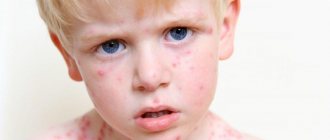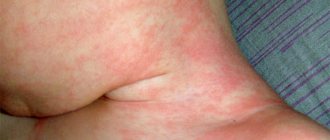Childhood infections are caused by a huge number of microorganisms. One of these is the Coxsackie virus. It belongs to the causative agents of childhood enteroviral infections with a polymorphic clinical picture. It is a highly contagious RNA virus and prefers the acidic environment of the stomach. However, it settles not only in the human gastrointestinal tract; practically any tissue and organs can become its target. The nervous system is often affected when infected. But the most likely manifestation of infection is diarrhea, general intoxication, and a characteristic rash. The disease is characterized by a generally favorable course, however, in some cases dangerous complications develop.
What is it: characteristics
In the international classification of diseases, the Coxsackie virus is designated as B-34.1 (this is its ICD-10 code).
The causative agent of the disease, like the ECHO virus, belongs to the group of enteroviruses, that is, intestinal infections. The place of their reproduction is the child’s gastrointestinal tract. But other organs and tissues can also be affected during infection.
Where did this virus come from? It was first isolated in the 50s of the last century from children's excrement in the American town of Coxsackie, which gave its name to this infection.
It is also called the “Turkish virus” because in the warm season, outbreaks of the disease often occur in the resorts of this country, as well as in other popular southern vacation spots.
Infection with the Coxsackie virus is indicated by rashes on the child’s palms and feet, and mouth ulcers.
The symptoms of the disease are partially similar to intestinal flu (as rotavirus is called), chickenpox, stomatitis, and acute polio.
Coxsackie belongs to the Picornavirus family, that is, small RNA viruses. It is divided into two groups - A and B, each of which consists of a set of specific serotypes.
Different types manifest themselves with similar signs of infection - rash, diarrhea, intoxication, but differ in localization and complications that can cause.
The Coxsackie virus parasitizes inside cells, a description of its spread is as follows:
- When entering the body, viral particles first occupy mucous and lymphoid tissues;
- then the parasites travel through the bloodstream into various organs, attacking their cells and causing inflammation;
- different types of the virus prefer their habitats - in muscles, in nerve cells, on the skin, in internal organs.
Some people mistake Coxsackie for herpes, due to the fact that these pathologies have a similar clinical picture. But this enterovirus is not a herpes infection. Symptoms, treatment, photos of herpes on the body can be found at the link.
Infection with the Coxsackie virus threatens preschoolers and children of primary school age. After 10 years, the risk of infection is no longer great. Adults rarely get this viral infection and tolerate it more easily.
Breastfed children are protected by maternal antibodies and therefore their risk of infection is not at all high. In infants under six months of age, infection with the Coxsackie virus is rarely diagnosed.
How is the Coxsackie virus transmitted?
Why is infection caused by the Coxsackie virus called dirty hands disease? Because a sick child, who due to his age is not yet accustomed to personal hygiene, becomes a carrier of infection.
By touching various objects with unwashed hands after visiting the toilet, the virus carrier infects them.
Other children, when touching contaminated things, may then put food into their mouths with dirty hands; some children have the habit of licking their fingers. This is why the infection spreads so quickly in kindergarten.
There are other ways of transmitting the disease:
- through contaminated drinking water or food;
- airborne droplet method - when coughing, sneezing, crying;
- placental - from mother to unborn child. The virus itself does not affect pregnant women much, but the baby may be born with a viral pathology.
Infection can also occur when swimming in a body of water infected with the Coxsackie virus. The virus enters the external environment along with the contents of the intestines.
Infectious agents are often found in wastewater samples, from where they spread further into water bodies, fields, and meadows. Therefore, the warm season is the most favorable period for infection.
In water, soil and food, enterovirus infection can remain pathogenic for a long time - up to 100 days. The infectious agent is active on household items for at least a week.
A specialist will tell you about diseases of the palms, feet and mouth caused by Coxsackie enterovirus:
CANCELLATION OF TOUR TO TURKEY. WHAT COMPENSATION CAN YOU EXPECT?
Officials did not impose any restrictions on the sale and formation of tours to Turkey . Thus, if a tour is canceled before its start date, the tour operator has the legal right to retain the costs incurred in organizing the tour.
The final amount of expenses actually incurred by him depends on the date of termination of the contract and many other factors. The exact figure is not specified in the law and depends only on the terms of the contract for the sale of tourism products, but the closer to the date of travel, the greater the fine will be .
How to distinguish from chickenpox and other diseases
How to determine that a child has been infected with the Coxsackie virus? The fact is that due to some symptoms, mainly rashes, the infection is sometimes mistaken for chickenpox.
They even make a diagnosis of “stomatitis” - when abscesses similar to ulcers form in the mouth.
What are the differences between enterovirus and other diseases:
- Coxsackie pox differs from chickenpox in that with this infection the rashes are not located throughout the body. They appear on the palms and soles of the feet, but the characteristic localization of chickenpox on the head, in the scalp, is absent.
- Itching in the area of the rash with the Coxsackie virus is less, but the pain is more intense. The child also has muscle pain, vomiting and diarrhea. Because of a sore throat, children cannot drink, and this is dangerous - they may become dehydrated.
It is important to correctly recognize the disease in order to prescribe adequate treatment and avoid complications.
You can learn how to treat postherpetic neuralgia at home from this publication.
If you are interested in what Epstein-Barr virus is, read our article.
Read about how and what to treat colds on the lips here: https://udermatologa.com/zabol/gerp/chem-i-kak-bystro-lechit-prostudu-na-gubah-luchshie-sredstva/
Treatment
If the disease passes without complications, then conventional therapy is used to eliminate it, as for ARVI. Treatment usually takes place at home and includes the following therapy:
- in case of extreme fever, antipyretic medications are given, for example, Nurofen ;
- to strengthen the immune system, the use of interferons and immunoglobulins is prescribed;
- in case of severe intoxication, it is necessary to use sorbents, for example, activated carbon;
- if there are wounds and blisters in the oral cavity, Tantum-Verde is used to treat them;
- if severe itching is observed, then taking antihistamines is necessary;
- If a bacterial infection is present, antibiotics .
High body temperature and an upset stomach in a baby lead to dehydration. For this reason, it is important to give your child enough water.
You need to call a pediatrician in certain cases, which are:
- pale skin;
- the formation of blue discoloration on the skin of the body, between the phalanges and near the ears;
- the appearance of symptoms of dehydration: lethargy, dry lips, rare urination, dizziness, fatigue and drowsiness, delirium;
- lack of appetite;
- prolonged fever;
- severe headaches.
Urgent hospitalization will be required in case of severe development of the disease and complications.
Diagnosis of the disease: what tests need to be taken
If the Coxsackie virus manifests itself with typical symptoms, then it can be diagnosed without special tests.
Laboratory diagnosis is required for atypical or asymptomatic disease:
- use the polymerase chain reaction method. PCR diagnostics helps to detect the presence of a virus in biological material (blood, urine, feces, mucus washes);
- serological tests - immunoglobulins (specific antibodies) to this virus are detected in the blood. If their activity (titer) is increased more than 4 times, this confirms the presence of infection.
To diagnose the disease, you also need to take a blood and urine test.
Cerebrospinal fluid is examined if symptoms of meningitis are present. In case of organ damage, X-rays, ECG and MRI examinations may be prescribed.
How long is a patient with Coxsackie virus contagious?
The period from infection to the appearance of the first signs, which is called incubation, with the Coxsackie virus lasts on average from 2 to 6 days (sometimes up to 10) . The peak of infectiousness is considered to be the second or third day of illness.
All biological fluids of the body, but most of all feces, pose a risk of infection to others. It is with feces that the virus will be excreted for the longest time - up to 8 weeks.
How long is a sick person contagious? It will continue to produce enterovirus for several more weeks. There are cases when the period of contagiousness lasts longer – up to several months.
An infected child should be immediately isolated from the group. Attending kindergarten, school, or other children's educational institution (preschool) is allowed after full recovery.
But this period cannot be less than 14 days. And in case of serous meningitis - at least 21 days.
In children's institutions, quarantine lasts 2 weeks. If new cases are identified during this period, the quarantine will be extended for another 14 days.
If a patient has a chronic infection, he can secrete the virus and be infectious for a year.
An adult patient with Coxsackie infection must take sick leave and be isolated from the work team until complete recovery.
When can you get vaccinated?
What to do if the time has come for the next vaccination, and the child gets sick with the Coxsackie virus? The vaccination will have to be postponed - but for how long?
After full recovery, at least a month should pass. But the decision about whether a child can be vaccinated must be made together with a pediatrician based on an examination and test results.
The fact is that in a person who has recovered from Coxsackie, the production of red blood cells may be blocked for some time. A general blood test is needed to assess the state of hemoglobin.
If there is such a possibility, it is better to consult an immunologist about the timing of vaccination.
WHAT ELSE SHOULD YOU PAY ATTENTION WHEN APPLYING FOR INSURANCE FOR THOSE GOING ABROAD?
An insurance policy is cheaper if it provides for a so-called deductible . Usually this is an amount of about 50-100 euros, which the tourist will have to pay for treatment out of his own pocket. Costs only above the specified amount are compensated by the insurance company. It has been calculated that the average cost of medical care provided in connection with the virus depends on the country of treatment and the severity of the disease and can vary from 60 euros in Bulgaria, 80 euros in Turkey and up to 1500 USD in the United States.
If the policy is included in a travel package, you should check in advance whether it includes a deductible. If it does, and there are concerns about a possible Coxsackie illness while on vacation, then it makes sense for a tourist (especially with children) to consider purchasing an additional insurance policy - without a deductible .
come back
Is it possible to get sick again?
Many parents have probably heard that after a child has had the Coxsackie virus, he develops immunity to this infection for life, like measles or chickenpox.
Therefore, mothers and fathers are confident that their child will no longer get sick with enterovirus.
Here we need to be clear - lifelong immunity will be serospecific. What does it mean? It is formed only to the serotype of the virus that the child suffered.
And Coxsackie has many such serological types - about 30. That is, the risk of becoming infected with one of them remains .
So, it is quite possible to get sick a second time with some type of this infection. True, many parents note that repeated illness is easier for the child to tolerate.
But you should be prepared for any option, including possible complications. A recurrence of the Coxsackie virus can lead to dangerous consequences.
IF SUDDENLY THE SITUATION IS RECOGNIZED UNSAFE, THEN IT WILL BE POSSIBLE TO REFUND THE ENTIRE TOUR AMOUNT?
The head of the legal service of ATOR, Nadezhda Efremova, explains that Rostourism’s statements in case of danger to tourists in a particular country can be divided into two types.
The first is a recommendation to be careful while on vacation. Such wording does not introduce any prohibitions or restrictions on travel to the country . In this case, if a tourist wants to cancel the tour “because he is afraid,” the refund is made in accordance with the terms of the contract for the sale of tourism products - on the terms signed by the parties.
The second option may include restrictions on the formation and implementation of tours to a particular country. In this regard, changes to flight programs may also be made. In this case, the refund of funds for unfulfilled obligations to the tourist is made in full - but there are currently no such notifications in Turkey.
Is it possible to wash, swim, walk?
Doctors have different opinions regarding bathing sick children:
- Some doctors say that you should not bathe your child until the rash goes away.
- Most pediatricians believe that water procedures are contraindicated only when the temperature is high and the baby is not feeling well. If the child tolerates the infection normally, then you can bathe him in the shower. Of course, not for long, without a washcloth, and then do not wipe the body with a towel, but lightly blot it.
- Rubbing with warm water will help relieve itching. But doctors do not recommend baths. If the rashes are painful, then it is better not to wet them at first; you can be patient with water procedures for a couple of days.
- Children who fall ill on vacation should not swim in the pool. Regarding sea water, opinions are again divided. Some doctors are in favor of banning sea bathing, others believe that there will be no harm from this.
- Walking is not prohibited if the child feels normal. A child with a fever clearly has no time for festivities - he needs bed rest. You need to walk away from crowded places, because someone who is sick with the virus is an active carrier of it. It is better to avoid exposure to the sun during this period.
You will find the causes, symptoms and signs, methods of treatment and prevention, as well as photos of herpangina in children in this article.
People often ask: what does it mean when igg antibodies to cytomegalovirus are detected? Find the answer to the question in this material.
HOW TO GET YOUR MONEY BACK FOR AN EARLY RETURN HOME.
This question may be asked by tourists who are afraid that upon arrival at the hotel they will find vacationers with suspicious rashes. If the situation is not recognized as an epidemic , the tourist can contact the operator with a request for compensation for lost services.
However, because the refusal of services occurred at the time of their provision, then the tour operator’s partners will not be able to sell them to other tourists. The same applies to the return air ticket. Therefore, refunds for unused services are unlikely .










